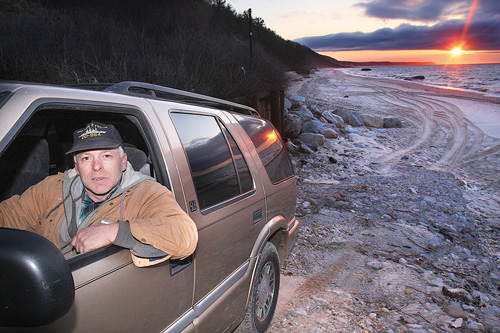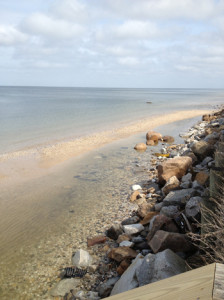After storms, the fate of Reeves Beach in doubt

Every summer, Reeves Park resident Brian Noone likes to pack his barbecue grill into the back of his truck and head down to Reeves Beach with his wife and two young children. They spend the afternoons swimming, then build campfires each night, just as Mr. Noone did with his parents and siblings when he was young.
“We live down there,” he said of the routine.
But this year may be different.
At low tide, Reeves Beach, on the north shore of Baiting Hollow, has hundreds of feet of sand stretching in both directions. But come down the ramp at some high tides and the beach is gone, completely submerged under the Long Island Sound, which now reaches up to the ramp and bluffs at the start of the beach.
Mr. Noone said it would be “devastating” to lose parts of the beach.

“That’s what this community lives for,” he said. “I think this community enjoys this beach more than any other community out there.”
The dramatic erosion that wiped out Reeves Beach is thanks to Hurricane Sandy and a series of winter storms that battered the North Fork this past year, experts said.
Now, town officials and engineers are planning to look closer at the shoreline to figure out how to manage the town’s most damaged beach before summer.
“It looks horrible right now … Reeves is by far the worst,” said Ray Coyne, the town’s recreation department head.
Mr. Coyne said the Riverhead Town beaches at Iron Pier and Wading River have “a lot of debris down there,” but the town will be able to clean and open those beaches in time for the summer season.
But Reeves Beach poses more complicated challenges, like where to put a lifeguard stand on the flooded beach.
“If we had opened it today, we couldn’t even get a lifeguard stand down during one of the [tide] cycles,” Mr. Coyne said, because the water comes right up to the bluffs at times.
He and the town engineers will assess the beach and present their findings to the Town Board in the coming weeks, he said.
Closing the beach for the summer, which would mean no town staffing and no swimming, is a last resort, he said.
“I just want to find out everything that we need to know to open this beach,” Mr. Coyne said. “[Closing the beach] really will not happen unless we have no other options left. If our backs are against the wall.”
Reeves Beach has disappeared beneath high tides in years past, said Eric Biegler, president of the Sound Park Heights Civic Association, which represents about 100 homeowners in the Reeves Park neighborhood near the beach.
“Every year the beach goes through a bit of a revitalization,” he said.
But this year, the beach hasn’t come back.
“This is unprecedented, in my opinion,” Mr. Biegler said. “Who knows how it’s going to correct itself?”
The civic association’s private beach, about 400 feet of shoreline west of the town beach, lost 25 feet of bluff during Sandy, Mr. Biegler said.
“We’re going to have a huge beach [this year], not because our beach came back but because our cliff got chopped off,” he said.
The new Sound shoreline in the area of Reeves Park and beyond now has areas that are completely under water during certain high tide cycles, he said. That means people traveling the beach will need to make sure they understand that their route onto the beach may be sealed off by the Sound hours later.
“You’re going to have to work through this,” Mr. Biegler said. “The whole of coastal Long Island is going to have to work through this.”
Drivers on the beach will also have to be more conscious of high and low tides. He proposed the town send messages to those who got permits to drive on the beach, warning them of the dangers of the new high tide marks.
Mr. Biegler said he was not “alarmed” yet, but he said he had concerns about the beach’s erosion and doesn’t want the town to close the beach.
“Ray [Coyne] is going to have to be creative,” Mr. Biegler said. “He can’t just close the beach … You have to adapt, you have to be flexible, you have to survive through this.
“[Reeves Beach] is a huge resource for the entire Town of Riverhead. As a community we don’t want to see the beach closed.”
The erosion of beaches, including Reeves Beach, is natural, said Stony Brook University professor Henry Bokuniewicz, who has a doctorate in geology and geophysics from Yale University.
The North Shore of Long Island is not one uniform beach, Mr. Bokuniewicz said, but rather a series of “compartments” formed by outcroppings of rocks, jetties and other underwater structures.
“It’s not like the South Shore where much of the shore is smeared together,” he said.
The area of Reeves Beach that was damaged is one such compartment, bordered by a series of rocky groins to the east and a submerged shipwreck to the west that forms a barrier to trap sand, he said.
Erosion normally occurs when rainstorms take sand off the bluffs or waves undercut them and cause large sections to collapse.
But while normal storms may also sweep sand off the beach, Sandy was by no means a normal storm, he said.
“In Sandy, many beaches went down to what’s called ‘pavement,’ ” he said. “All that was left was this hard, packed-down beach.”
Because the storm was so huge and because of nor’easters since Sandy, including February’s record-setting blizzard, the sand that was pulled out to sea hasn’t been redistributed onto the beaches yet, he said.
“If the calm conditions return, beaches can recover in six weeks, but the problem is calm conditions don’t persist,” Mr. Bokuniewicz said. “The clock is trying to get to reset, and it keeps getting pushed back and pushed back and pushed back.”
Mr. Bokuniewicz said he believes the beach will eventually return, though he couldn’t predict when.
“How fast the beach recovers depends on the sand that’s in that compartment [near Reeves Beach],” he said.
But it’s possible that when the beach recovers, it may not be the same, he said.
While some sand may have settled in the compartment, other sand may have been dumped on sand bars far offshore; that sand will likely not come back, changing the shape of the new Reeves Beach, he said.
“It’s really sort of the luck of the draw as to where the sand was redistributed after Sandy,” Mr. Bokuniewicz said. “It may come back, but it may not.”
Mr. Coyne said the town engineers will look at all possibilities, including seeing if the beach will naturally return or filling in the area with sand to restore Reeves Beach.
Mr. Biegler said he favored “a little intervention” if needed in the form of dumping new sand onto the beach, but warned the town needs to be careful.
In general, Mr. Bokuniewicz said he believes it’s “good to … put [sand] back on the beach,” but he warned that the sand may soon be eroded away if another big storm strikes, and he said the measure can be costly.
“Beach nourishment is fairly benign, environmentally, but it is a crapshoot,” he said. “It doesn’t solve the erosion problem, but it treats the problem. You never know when that next event is going to come through and push that sand to the west or push the sand to the east.
“You pay your money and take your chances.”
But not everyone is concerned about erosion.
Riverhead native and lifelong Reeves Park resident Jeff Fuchs, 43, made his way up the storm-battered beach access ramp in his GMC four-wheel drive vehicle Tuesday evening after hanging out with friends at the beach after work.
He said he’s seen the beach come and go from many storms over the years and has no doubt Reeves Beach would return.
“No matter what happens to it the beach it always comes back,” Mr. Fuchs said.
This story first appeared in the March 21 News-Review newspaper.








